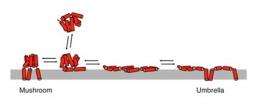SANS tracks cell death protein invading biomimetic mitochondrial membrane

(PhysOrg.com) -- An international team of biochemists, biophysicists, and neutron scientists are using a combination of fluorescence and small-angle neutron scattering (SANS) techniques to assist biochemists in better understanding how a protein associated with cell death incorporates into membranes.
Programmed cell death, or apoptosis, is a naturally occurring and necessary biological process. In apoptosis, the 192 amino acid BAX protein inserts itself into mitochondrial membranes, causing their contents to leak out and their eventual demise.
This is our fate as mammals. In a typical human, some 50 to 70 million cells die daily as a result of apoptosis. Old cells complete their life cycle and die. New cells are born.
In utero, apoptosis has a creative role, responsible for the separation of the fingers of the growing fetus. However, a defective apoptosis function (i.e., too little or too much) has been implicated in a variety of diseases, including atrophy of limbs and organs and some cancers.
The collaboration is led by Cécile Fradin, a biophysicist from McMaster University, which is located in Hamilton, Ontario, from the Canadian Neutron Beam Center at Chalk River (Ontario, Canada). The team also includes other researchers from McMaster and from ORNL's Neutron Sciences Directorate.
In hopes of getting a better understanding of how the BAX protein interacts with membranes, the researchers combined long-known fluorescence techniques with neutron scattering at the General-Purpose SANS instrument at the ORNL High Flux Isotope Reactor.
The cell mimics were vesicles (hollow spheres) made of bilayers with a lipid composition similar to mitochondrial membranes. These so-called liposomes are also used in medicine, where, filled with drugs, they can be functionalized to target and treat cancer and other diseases.
The researchers wanted to closely approximate a mitochondrial membrane. "One can never get it exactly right," said John Katsaras, a biophysicist in ORNL's Biology and Soft Matter Division. "A cell membrane has a myriad of different types of lipids and proteins. In your model system, you try to incorporate the major lipid groups and actively mimic as closely as you can."
The liposomes were fabricated by extrusion through polycarbonate filters with 50 nanometer diameter pores.
The full-length recombinant BAX protein was introduced to the liposomes. Fluorescence methods found that about 15 BAX proteins incorporate into one 50 nm diameter liposome; however, SANS measurements indicate that a significant amount of the protein's mass protrudes above the membrane and causes the membrane to thin.
SANS proved to be an ideal technique for studying the impact of the BAX protein on these biomimetic membranes, Katsaras affirmed. The researchers found neutrons to be a promising technique for studies of lipid-protein interaction.
SANS detects the protein assemblies through the use of contrast variation, emphasizing certain parts of the membrane while de-emphasizing others. "For example, under a given condition, I can make the entire lipid bilayer disappear, and I can look at only what the protein is doing. Under other conditions, I can make the protein disappear and just look at the bilayer, etc."
"To begin with, we were interested in how a BAX protein associates with a cell membrane. Does it fully incorporate or does some of it protrude above the membrane?" Katsaras said.
The researchers also looked at the role of tBid, an activator that modifies BAX's structure, enabling it to insert into the membrane. "Basically, we found that if you put in a lot of the tBid you get the BAX to bind to these vesicles at some kind of theoretical equilibrium," said Katsaras.
"Cell apoptosis is programmed cell death. If a protein that causes this incorporates into the cell's membrane, pores are formed, causing the cell's contents to leak out. We want to know under what conditions."
A more fundamental question that this research can address concerns the length of cell life, Katsaras explained. "Sometimes red blood cells die early. They don't go through their entire life cycle. People are interested in what is the natural life cycle of the cell and what causes cell death."
The SANS research shows the thickness of the protein layer, the radius of the vesicle, and the thickness of the bilayer. "You can then more systematically follow what kind of changes occur--what effect does this protein have on the membrane. Some of these questions are difficult to answer by other techniques, but neutrons lend themselves ideally to structural studies of biological materials," Katsaras said.
SANS helped the researchers determine BAX's interaction with mitochondrial mimetic membranes. The scattering showed that the BAX proteins do not assemble in one place on the liposome but are distributed on its surface. This hints at a permeabilization mechanism where BAX forms small, dynamic pores rather than large stable ones.
Neutron scattering also showed that not all of the BAX molecules are fully incorporated into the membrane but can protrude significantly from its surface, an indication that more than one membrane conformation may exist for this protein. BAX was also found to cause the membrane to thin, an effect that is accompanied by an increase in the liposome's radius. Although this thinning is well established for pore-forming peptides, the researchers say this is the first time that anyone has reported membrane thinning for any full-length BAX family protein.
"One of the key things that we were looking at here is can neutron scattering techniques fill in the blanks when it comes to biological problems that other techniques can't resolve," said Katsaras. "It is a powerful complementary technique."
"Soft materials rich in hydrogen, magnetic structure, and stresses in engineering materials--that is what neutrons do best. We are deeply committed to developing this science method for biologically relevant systems."
Provided by Oak Ridge National Laboratory

















